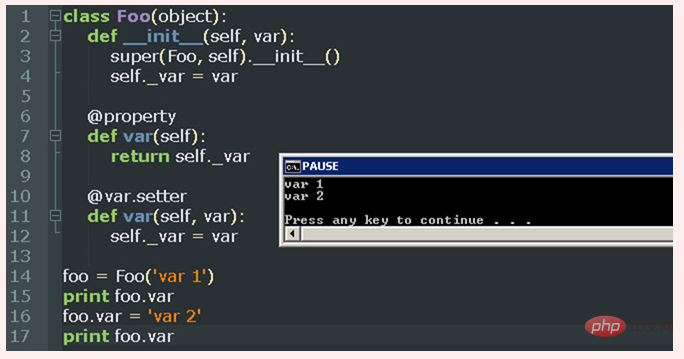Python 데코레이터에 대한 자세한 설명

파이썬 데코레이터 상세 설명
파이썬 데코레이터 상세 분석
데코레이터란 무엇인가요?
추천 학습: Python 동영상 튜토리얼
Python 데코레이터(fuctional 데코레이터)는 원래 함수 이름(또는 클래스 이름)을 변경하지 않고 Python을 제공하는 것이 목적입니다. 기능은 새로운 기능을 추가합니다.
이 함수의 특별한 점은 반환 값도 함수라는 것입니다. 이 함수는 "원래" 함수가 포함된 함수입니다.
일반적으로 말하면 원래 함수 코드를 확장하려는 경우 가장 많이 사용됩니다. 직접적인 방법은 코드를 수정하는 것입니다. 예:
import time
def f():
print("hello")
time.sleep(1)
print("world")
이것은 우리의 가장 독창적인 함수이며, 이 함수의 총 실행 시간을 기록하려고 합니다. 가장 쉬운 방법은 원래 코드를 변경하는 것입니다.
import time
def f():
start_time = time.time()
print("hello")
time.sleep(1)
print("world")
end_time = time.time()
execution_time = (end_time - start_time)*1000
print("time is %d ms" %execution_time)
하지만 실제 작업에서는 핵심 코드를 직접 수정할 수 없는 경우가 있기 때문에 원래 코드를 변경하지 않고 다른 함수를 정의할 수 있습니다. (단, 해당 함수를 다시 실행해야 적용됩니다.)
import time
def deco(func):
start_time = time.time()
f()
end_time = time.time()
execution_time = (end_time - start_time)*1000
print("time is %d ms" %execution_time)
def f():
print("hello")
time.sleep(1)
print("world")
if __name__ == '__main__':
deco(f)
print("f.__name__ is",f.__name__)
print()
여기서 deco 함수는 함수를 매개변수로 사용하고 이 함수에 타이밍 함수를 포함시킵니다. 그러나 이러한 수천만 개의 함수의 기능을 확장하려면 deco() 함수를 천만 번 실행해야 합니다. , 그래서 이것은 이상적이지 않습니다. 다음으로, 데코레이터를 사용하여 구현해 볼 수 있습니다. 먼저 데코레이터의 원래 모습을 살펴보겠습니다. value도 함수입니다.
f() 함수는 반환 함수 래퍼() 내에서 실행됩니다. 그런 다음 함수 f() 앞에 @deco를 추가하면
f() 함수는 다음과 같습니다. 타이밍 기능이 주입되었습니다. 이제 f()가 호출되는 한 "더 많은 기능을 갖춘 새로운 함수"로 변환되었습니다.
(원래 함수를 반복할 필요 없음)
확장 1: 고정 매개변수가 있는 데코레이터
.import time
def deco(f):
def wrapper():
start_time = time.time()
f()
end_time = time.time()
execution_time = (end_time - start_time)*1000
print("time is %d ms" %execution_time )
return wrapper
@deco
def f():
print("hello")
time.sleep(1)
print("world")
if __name__ == '__main__':
f()확장 2: 고정된 매개변수가 없는 데코레이터
import time
def deco(f):
def wrapper(a,b):
start_time = time.time()
f(a,b)
end_time = time.time()
execution_time = (end_time - start_time)*1000
print("time is %d ms" % execution_time)
return wrapper
@deco
def f(a,b):
print("be on")
time.sleep(1)
print("result is %d" %(a+b))
if __name__ == '__main__':
f(3,4)
확장 3: 여러 데코레이터를 사용하여 함수 꾸미기
import time
def deco(f):
def wrapper(*args, **kwargs):
start_time = time.time()
f(*args, **kwargs)
end_time = time.time()
execution_time_ = (end_time - start_time)*1000
print("time is %d ms" %execution_time)
return wrapper
@deco
def f(a,b):
print("be on")
time.sleep(1)
print("result is %d" %(a+b))
@deco
def f2(a,b,c):
print("be on")
time.sleep(1)
print("result is %d" %(a+b+c))
if __name__ == '__main__':
f2(3,4,5)
f(3,4)import time
def deco01(f):
def wrapper(*args, **kwargs):
print("this is deco01")
start_time = time.time()
f(*args, **kwargs)
end_time = time.time()
execution_time = (end_time - start_time)*1000
print("time is %d ms" % execution_time)
print("deco01 end here")
return wrapper
def deco02(f):
def wrapper(*args, **kwargs):
print("this is deco02")
f(*args, **kwargs)
print("deco02 end here")
return wrapper
@deco01
@deco02
def f(a,b):
print("be on")
time.sleep(1)
print("result is %d" %(a+b))
if __name__ == '__main__':
f(3,4)Decorator 호출 순서
Decorator를 중첩할 수 있으므로 데코레이터를 사용한 후의 순서는 무엇입니까?
Python의 "@" 구문 설탕의 경우 데코레이터는 @ 구문 설탕 선언과 반대 순서로 호출됩니다.
이 예에서는 "f(3, 4) = deco01( deco02(f(3) , 4)))".
Python 내장 데코레이터Python에는 클래스와 관련된 세 가지 내장 데코레이터가 있습니다: staticmethod, classmethod 및 property.
staticmethod 클래스 정적 메서드입니다. 클래스 메소드와 멤버 메소드의 차이점은 self 매개변수가 없으며 클래스가 인스턴스화되지 않고 호출될 수 있다는 것입니다. 클래스 메소드와 멤버 메소드의 차이점은 수신된 첫 번째 매개변수가 self(클래스 인스턴스의 포인터)가 아니라는 것입니다. ), 하지만 cls(현재 클래스의 특정 유형) property는 속성을 의미하며, 클래스 인스턴스를 통해 직접 접근할 수 있는 정보를 나타냅니다.
여기서는 staticmethod와 classmethod에 대해 소개하지 않겠습니다. 예를 통해 살펴보겠습니다.
Python 새 스타일 클래스의 경우 위의 "@var.setter" 데코레이터로 장식된 멤버 함수가 제거되면 Foo.var 속성은 읽기 전용 속성이 되며 "foo . var = 'var 2′"는 할당을 수행할 때 예외를 발생시킵니다. 그러나 Python 클래식 클래스의 경우 선언된 속성은 읽기 전용이 아니므로 "@var.setter" 데코레이터를 제거하더라도 오류가 보고되지 않습니다.요약
 이 글에서는 Python 데코레이터의 몇 가지 용도를 소개합니다. 데코레이터의 코드는 비교적 이해하기 쉽습니다. 몇 가지 예를 통해 연습해 보면 이해하기 쉽습니다.
이 글에서는 Python 데코레이터의 몇 가지 용도를 소개합니다. 데코레이터의 코드는 비교적 이해하기 쉽습니다. 몇 가지 예를 통해 연습해 보면 이해하기 쉽습니다.
위 내용은 Python 데코레이터에 대한 자세한 설명의 상세 내용입니다. 자세한 내용은 PHP 중국어 웹사이트의 기타 관련 기사를 참조하세요!

핫 AI 도구

Undresser.AI Undress
사실적인 누드 사진을 만들기 위한 AI 기반 앱

AI Clothes Remover
사진에서 옷을 제거하는 온라인 AI 도구입니다.

Undress AI Tool
무료로 이미지를 벗다

Clothoff.io
AI 옷 제거제

Video Face Swap
완전히 무료인 AI 얼굴 교환 도구를 사용하여 모든 비디오의 얼굴을 쉽게 바꾸세요!

인기 기사

뜨거운 도구

메모장++7.3.1
사용하기 쉬운 무료 코드 편집기

SublimeText3 중국어 버전
중국어 버전, 사용하기 매우 쉽습니다.

스튜디오 13.0.1 보내기
강력한 PHP 통합 개발 환경

드림위버 CS6
시각적 웹 개발 도구

SublimeText3 Mac 버전
신 수준의 코드 편집 소프트웨어(SublimeText3)

뜨거운 주제
 7715
7715
 15
15
 1641
1641
 14
14
 1395
1395
 52
52
 1289
1289
 25
25
 1232
1232
 29
29
 PHP와 Python : 다른 패러다임이 설명되었습니다
Apr 18, 2025 am 12:26 AM
PHP와 Python : 다른 패러다임이 설명되었습니다
Apr 18, 2025 am 12:26 AM
PHP는 주로 절차 적 프로그래밍이지만 객체 지향 프로그래밍 (OOP)도 지원합니다. Python은 OOP, 기능 및 절차 프로그래밍을 포함한 다양한 패러다임을 지원합니다. PHP는 웹 개발에 적합하며 Python은 데이터 분석 및 기계 학습과 같은 다양한 응용 프로그램에 적합합니다.
 Python vs. JavaScript : 학습 곡선 및 사용 편의성
Apr 16, 2025 am 12:12 AM
Python vs. JavaScript : 학습 곡선 및 사용 편의성
Apr 16, 2025 am 12:12 AM
Python은 부드러운 학습 곡선과 간결한 구문으로 초보자에게 더 적합합니다. JavaScript는 가파른 학습 곡선과 유연한 구문으로 프론트 엔드 개발에 적합합니다. 1. Python Syntax는 직관적이며 데이터 과학 및 백엔드 개발에 적합합니다. 2. JavaScript는 유연하며 프론트 엔드 및 서버 측 프로그래밍에서 널리 사용됩니다.
 PHP와 Python 중에서 선택 : 가이드
Apr 18, 2025 am 12:24 AM
PHP와 Python 중에서 선택 : 가이드
Apr 18, 2025 am 12:24 AM
PHP는 웹 개발 및 빠른 프로토 타이핑에 적합하며 Python은 데이터 과학 및 기계 학습에 적합합니다. 1.PHP는 간단한 구문과 함께 동적 웹 개발에 사용되며 빠른 개발에 적합합니다. 2. Python은 간결한 구문을 가지고 있으며 여러 분야에 적합하며 강력한 라이브러리 생태계가 있습니다.
 Windows 8에서 코드를 실행할 수 있습니다
Apr 15, 2025 pm 07:24 PM
Windows 8에서 코드를 실행할 수 있습니다
Apr 15, 2025 pm 07:24 PM
VS 코드는 Windows 8에서 실행될 수 있지만 경험은 크지 않을 수 있습니다. 먼저 시스템이 최신 패치로 업데이트되었는지 확인한 다음 시스템 아키텍처와 일치하는 VS 코드 설치 패키지를 다운로드하여 프롬프트대로 설치하십시오. 설치 후 일부 확장은 Windows 8과 호환되지 않을 수 있으며 대체 확장을 찾거나 가상 시스템에서 새로운 Windows 시스템을 사용해야합니다. 필요한 연장을 설치하여 제대로 작동하는지 확인하십시오. Windows 8에서는 VS 코드가 가능하지만 더 나은 개발 경험과 보안을 위해 새로운 Windows 시스템으로 업그레이드하는 것이 좋습니다.
 Python에서 비주얼 스튜디오 코드를 사용할 수 있습니다
Apr 15, 2025 pm 08:18 PM
Python에서 비주얼 스튜디오 코드를 사용할 수 있습니다
Apr 15, 2025 pm 08:18 PM
VS 코드는 파이썬을 작성하는 데 사용될 수 있으며 파이썬 애플리케이션을 개발하기에 이상적인 도구가되는 많은 기능을 제공합니다. 사용자는 다음을 수행 할 수 있습니다. Python 확장 기능을 설치하여 코드 완료, 구문 강조 및 디버깅과 같은 기능을 얻습니다. 디버거를 사용하여 코드를 단계별로 추적하고 오류를 찾아 수정하십시오. 버전 제어를 위해 git을 통합합니다. 코드 서식 도구를 사용하여 코드 일관성을 유지하십시오. 라인 도구를 사용하여 잠재적 인 문제를 미리 발견하십시오.
 PHP와 Python : 그들의 역사에 깊은 다이빙
Apr 18, 2025 am 12:25 AM
PHP와 Python : 그들의 역사에 깊은 다이빙
Apr 18, 2025 am 12:25 AM
PHP는 1994 년에 시작되었으며 Rasmuslerdorf에 의해 개발되었습니다. 원래 웹 사이트 방문자를 추적하는 데 사용되었으며 점차 서버 측 스크립팅 언어로 진화했으며 웹 개발에 널리 사용되었습니다. Python은 1980 년대 후반 Guidovan Rossum에 의해 개발되었으며 1991 년에 처음 출시되었습니다. 코드 가독성과 단순성을 강조하며 과학 컴퓨팅, 데이터 분석 및 기타 분야에 적합합니다.
 터미널 VSCODE에서 프로그램을 실행하는 방법
Apr 15, 2025 pm 06:42 PM
터미널 VSCODE에서 프로그램을 실행하는 방법
Apr 15, 2025 pm 06:42 PM
vs 코드에서는 다음 단계를 통해 터미널에서 프로그램을 실행할 수 있습니다. 코드를 준비하고 통합 터미널을 열어 코드 디렉토리가 터미널 작업 디렉토리와 일치하는지 확인하십시오. 프로그래밍 언어 (예 : Python의 Python Your_file_name.py)에 따라 실행 명령을 선택하여 성공적으로 실행되는지 여부를 확인하고 오류를 해결하십시오. 디버거를 사용하여 디버깅 효율을 향상시킵니다.
 VScode 확장자가 악의적입니까?
Apr 15, 2025 pm 07:57 PM
VScode 확장자가 악의적입니까?
Apr 15, 2025 pm 07:57 PM
VS 코드 확장은 악의적 인 코드 숨기기, 취약성 악용 및 합법적 인 확장으로 자위하는 등 악성 위험을 초래합니다. 악의적 인 확장을 식별하는 방법에는 게시자 확인, 주석 읽기, 코드 확인 및주의해서 설치가 포함됩니다. 보안 조치에는 보안 인식, 좋은 습관, 정기적 인 업데이트 및 바이러스 백신 소프트웨어도 포함됩니다.




